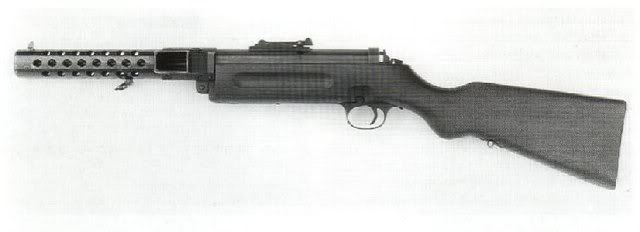 9mm ZK 383:
9mm ZK 383: Some sixty of these Czech weapons are in use with the Guardia Civil.
7.65mm Steyr-Solothurn S1-100 (7.65mm M32/SGss): Equipping infantry units 120 of these sturdy guns are now in service, the 7.65mm Parabellum cartridge was an unusual choice. These were passed to the Guardia Civil in 1940.
 7.65mm MP28 (M28/SGs):
7.65mm MP28 (M28/SGs): Infantería de Marina troops received around a hundred of these guns for the assault troops and use aboard ships in 1928. These were passed to the Guardia Civil in 1940.
 9mm Machine Gun Lanchester No.1 Mk I (9mm M37/L):
9mm Machine Gun Lanchester No.1 Mk I (9mm M37/L): developed by the Sterling Armament Company at Dagenham, Essex. An order for 500 was cancelled in 1935 but post-war the order was re-instated for the Infantería de Marina. In early 1940 another batch of 500 was ordered for the Marines. This gun is 33.5in long, weighs 9.57lbs, rate of fire (cyclic) is 600 rpm and muzzle velocity is 1,245 ft/sec.
 9mm HAFDASA C-4 (9mm M41/HA):
9mm HAFDASA C-4 (9mm M41/HA): developed by Argentine firm HAFDASA derived from the HAFDASA 'Ballester-Rigaud C1' model rifle, which was based on the famous Beretta Model 1918/30 sub-machinegun that was used by the police of the capital. The Criolla ("Native") C-2 was originally designed for crews of armoured vehicles in 1938 and was the first production model with a folding stock. The C-4 is based on the C-2 design, and is chambered in 9mm and .45 calibres. It has an aluminium lower receiver and is fed from a wide box magazine (50 rounds for 9x19mm Parabellum rounds and 40 rounds in .45 ACP) which uses two internal double-stack columns. A feed selector controls which column to feed from and placing the feed selector in its central position prevents the weapon from firing. Its magazine insert has a dust cover that folds open forward to form a grip shrouding the front of the magazines. The C-4 is available with a fixed wooden stock, folding metal stock (C-4P for paratroopers), full rifle stock (as the Z-4) and also comes as a machine pistol which predates and even outperforms many modern submachine guns in performance. The body is built out of forged aluminium and is painted in green, black, or brown. As with all the weapons manufactured by HAFDASA, the C4 is a practically unbreakable and strong weapon, though quite heavy
Thompson M/34: Around 150 confiscated 0.45in Thompson sub-machine guns destined for FUM terrorists are in use with I Division troops.
 Halcón M-1943:
Halcón M-1943: a submachine gun of Argentine origin and is chambered in both 9x19mm Parabellum for the Army and .45 ACP for Police Forces. This weapon is comparable in quality and performance with the Thompson submachine gun. The Halcón M-1943 has a fixed stock protruding from its grip section. It weighs 4.75kg, is 850mm long, the rate of fire is 700rpm with an effective range of 200m. It uses 30/36/40 round box magazines.
The later Halcón M-1946 came with an under-folding stock.











